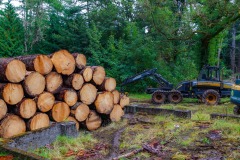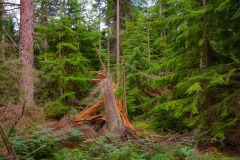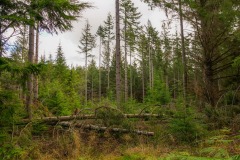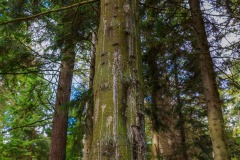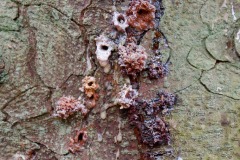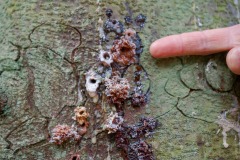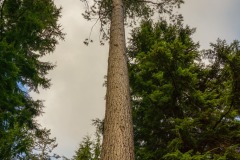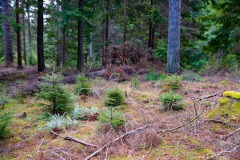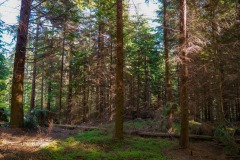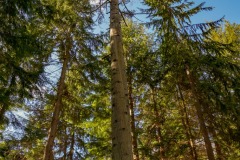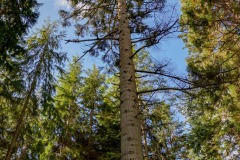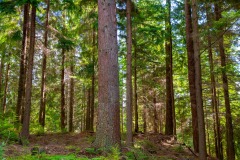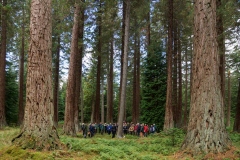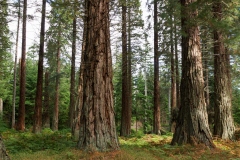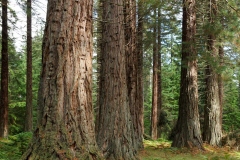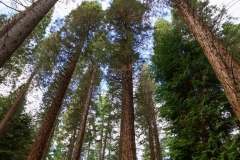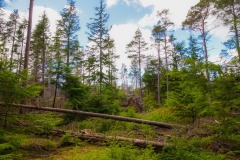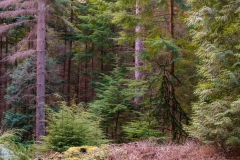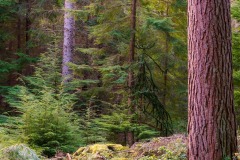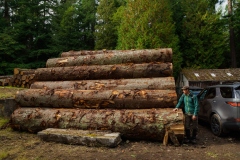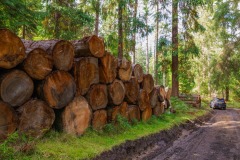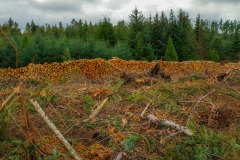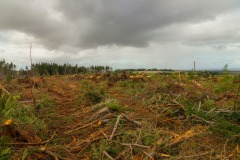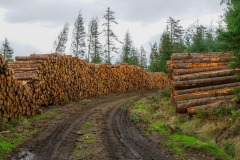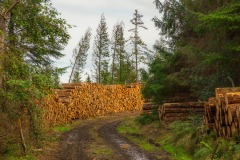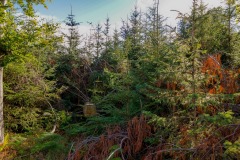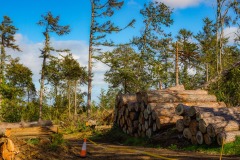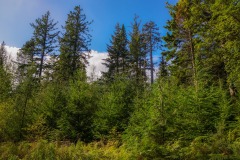FR02

In September 2022, a joint meeting of the Continuous Cover Forestry Group (CCFG), Royal Scottish Forestry Society (RSFS) and Royal Forestry Society (RFS) was held at Kyloe Wood, Northumberland, England. The group was hosted by Scottish Woodlands Ltd who have been responsible for managing the forest over many years. The forest is well known for the diversity of species that have been planted and for the long-time interest of the owners in transforming the forest to CCF. Located in the North-East of England, the woodland was badly damaged during Storm Arwen on 26/27 November 2021. This report provides a brief description of the forest and includes a gallery of images that illustrate the species, silvicultural systems and woodland conditions. Included with the gallery are images of the storm damage and salvage operations.

Introduction
Kyloe Wood is a productive conifer woodland of 400 ha situated on the Kyloe Hills approximately 10 km south of Berwick-upon-Tweed and 3 km inland from the North Sea. The woodland overlooks the Holy Island of Lindisfarne to the east and 20 km inland to the south-west are the Cheviot Hills. Altitudes range from 91-200 m above sea level with an average rainfall of 625 mm which is supplemented by “sea hags” (sea mists). Soils range from boulder clay, fell sandstone and quartz dolerite to the Scremerston coal group, some of which overlies limestone. Despite being a relatively low rainfall area, the clay component helps to maintain moisture in most of the soils.
The woodland is privately owned. It was largely established between 1890 and 1920 by the Leyland family. Up to 90 species of conifer were planted, including a 30 ha block of mountain pine (Pinus mugo). In 1920, the woodland passed to the Mitchell family, who owned and actively managed the forest for nearly 50 years. During this period, it was recognised that many of the tree species were starting to regenerate naturally. In 1968, Kyloe was sold to its present owners, a private family trust. The woodland has been managed by local office of Scottish Woodlands, located nearby in Alnwick, Northumberland, for several decades.
The owners have an interest in sustaining established management traditions at Kyloe Wood and have several long-term objectives. These include: 1. maintain continuous production of commercial conifer species; 2. promote species and structural diversity; 3. cultivate large trees; 4. Maintain and promote the biodiversity, conservation and natural heritage features.
In addition to active management of the woodland, there have been several significant natural disturbance events over the years. As a result, the forest comprises a mosaic of even-aged and irregular-structure stands. At the present time, approximately 50% of the forest is actively managed on principles of continuous cover forestry (CCF).
The entire forest is certified and complies with the UK Forestry Standard. This facilitates access to markets and the sale of sustainably-sourced timber. An important requirement of certification is that the forest must maintain open areas, which at Kyloe is heath with heather (Calluna vulgaris) and birch regen (Betula pendula).
Species composition
The forest contains a very wide range of conifer species that were planted over a period of more than 100 years. Many of the stands contain unusual mixtures and species not commonly planted at the present time. These legacy plantings are of great interest due to the resilience they bring to the forest and as a resource for observing species performance in productive forest conditions. Among the species noted during the visit were: oriental spruce (Picea orientalis), Norway spruce (Picea abies), Sitka spruce (Picea sitchensis), Corsican pine (Pinus nigra var laricio), Scots pine (Pinus sylvestris), giant redwood (Sequoiadendron giganteum), coast redwood (Sequoia sempervirens), Douglas fir (Pseudotsuga menziesii), western hemlock (Tsuga hereophylla) and Monkey puzzle (Araucaria araucana). A range of broadleaf species were also present.
The current composition of the forest is 88% productive conifer species, 6% broadleaves and 6% open areas. The structure can be described as mostly mixed-conifer stands. 50% is even-aged and 50% is CCF. Species that have traditionally performed well in the forest include Sitka spruce, Douglas fir and Corsican pine. Others with moderate to good productivity include Scots pine, larch (European, Japanese, hybrid) (Larix spp.) and Norway spruce. In recent years, Corsican pine has been infected with red band needle blight (Dothistroma pini) and is gradually being replaced with western red cedar (Thuja plicata).
Conservation and Amenity Values
The forest is accessible to the public via several footpaths and rights of way. Two crags located on the property are very popular with climbers.
The forest is now supported by a management grant from Countryside Stewardship (Funding Programme of the UK Department for the Environment, Food and Rural Affairs [DEFRA]) to maintain and promote biodiversity, and to support a range of conservation management interventions. This amounts to an annual payment of £100/ha for the whole forest. Of particular importance is the resident population of red squirrel (Sciurus vulgaris) and the whole forest is now classed as a red squirrel reserve. Other important species include nightjar (Caprimulgus europaeus) and goshawk (Accipiter gentilis).
Meaures include:
- Monitor and support red squirrel (Sciurus vulgaris) populations
- Maintain and promote a diversity of conifer species for red squirrel. Norway spruce, for example, is especially favoured.
- Trap and remove grey squirrels (Sciurus carolinensis)
- Monitor and support colonisation of the forest by pine marten (Martes martes)
- Provide and maintain nest boxes (but no confirmed sightings).
- Deer management – currently there is a large population of roe deer (Capreolus capreolus) that requires active management to control browse pressure on regenerating seedlings
- Ride mowing to increase biodiversty and habitat for woodland plants, butterflies and other wildlife
- Deadwood – maintain a proportion of standing and down coarse woody debris to promote biodiversity and habitat for birds and wildlife, including woodpeckers and beetles.
- Open space – currently the open area is around 6% of the property and this is likely to increase slightly in response to requirements of the UK Forestry Standard.
- The broadleaf component is currently 6% of the forest area, which will be maintained and may increase in the future.
Deer Populations and Management
Deer management is important for the healthy natural regeneration of the forest. There is a resident population of roe deer of around 100 (25 per 100 ha; considered a high density). Approximately 50 animals are culled each year. This is a level of cull that keeps damage within acceptable limits and enables planted seedlings to establish in most areas without the need for fencing.
Fallow deer (Dama dama) and red deer (Cervus elaphus) have also been seen in the forest, but numbers are small. Only two fallow deer and one red deer have been shot in the last 10 years.
It is a constant challenge to control and regulate the roe deer population. Numbers are replenished by new births from within the resident herd, and some movement in from outside. Shelter and cover provided by the irregular forest structure is beneficial for deer. Storm Arwen has led to more open areas across the forest that will likely make it easier for stalkers to spot and shoot deer.
Deer fencing is not used in the forest due to high costs. However, where “soft” conifers (e.g., true firs (Abies spp.), Atlas cedar (Cedrus atlantica), western red cedar) or oak (Quercus spp.) are being planted, good results have been obtained with temporary plastic mesh around small groups, forming micro-exclosures. These are cost-effective and can be moved and re-used once the planted seedlings are beyond risk of significant damage. At the present time, Trico (a deterrent product pasted on the leaders of newly planted seedlings) has not been trialled or used in the forest.
Forest Health
Several pests and diseases are present in the forest. These are monitored and controlled by removing damaged trees during thinning interventions. Of note are great spruce bark beetle (Dendroctonus micans) that is serious pest of spruce in the forest. Similarly, red band needle blight is a fungal pathogen of pine (Pinus spp.) and an especially significant problem in Corsican pine. Having a diverse range of species is one of the most important features of the forest that maintains resilience and limits the impact of damage from pests and diseases.
Wind
Wind is the most important natural disturbance in the forest. This is partly due to its coastal location. Damage is generally worst when storms and strong winds come from the north and east. Some damage tends to occur every year but is rarely significant. However, occasional severe storms have had led to “catastrophic” damage in some areas of the forest. The most recent major storms have been 1992 and 2021 – both coming in from the north.
Storm Arwen occurred on 26/27 November 2021. It is estimated that 30,000 tonnes of timber was blown down during this single event. This volume is equivalent to 10 years of normal production from the forest. This has prompted a major salvage operation that was anticipated to be completed by 2024. Damage was classed as “catastrophic” in stands that were largely or completely blown down, or “sporadic” where the damage was less severe. A combination of planting and natural regeneration is being used to re-stock the wind-damaged areas.
Storm damage was most serious in areas on upslopes with a northern aspect. Most of these were stands of Sitka spruce and most of this material was sold at good prices. Overall, approximately 50% of the windblown volume was Sitka spruce and 50% was larch, western hemlock and western red cedar.
A high proportion of the damage was in the form of windsnap. This is because the soils are generally well-drained and trees are moderately deep-rooting. Most trees snapped in the lower 3 m above the ground; a lot of waste is inevitable from lower boles of trees that are unusable.

The forest has a long tradition for growing and marketing large-dimension timber. This is not normally considered a disadvantage and rarely are there issues finding markets for large timber of pine, larch and spruce. The main issue that arises from a large amount of storm damage is that the market can usually only handle a small, steady supply of material and a storm brings a large volume for sale at one time. One species where there are fewer limitations is Douglas fir. This species is generally in demand and has a high value that increases with log size.
A few general comments on the damage are that stands on the north and east were most affected. Young stands were not affected. Coppice beech (Fagus sylvatica) areas were also not affected. There was damage in some thinned stands but the scale of impact depended on the location of the stand relative to the northern edge of the forest. Generally, the gale blew across Kyloe Wood with the edge stands buffeting the wind and preventing a domino effect elsewhere.

General Management Approach
In normal years, the management team aim to sustain a thinning and selective felling programme of 3,000 t/year. A 10-year felling plan is used to guide the progression of forest operations. Thinning of stands takes place on a 6-7 year cycle. Natural regeneration is used where it appears and re-stocking is undertaken on clear-fell sites or to enrich small openings in CCF areas. A long-term plan is to reduce the area of Sitka spruce to 15-18% of the forest area, and to diversify the range of species.
Scottish Woodlands has a close working relationship with the owners. The company has a large professional staff with a high level of skill in planting and harvesting commercial forests. Nonetheless, CCF is considered by the forestry team to be “management-intensive” and there are limits to the amount of time that foresters can spend working in the woods, partly due to overall workload elsewhere.
Several issues related to management were highlighted during discussions. CCF is generally considered a specialist area of interest among professional foresters and currently there are relatively few practitioners with the requisite skills or experience. There is also a lack of skilled labour able to cut large-dimension trees with chainsaws. Further, specialist equipment is required to handle and remove these trees from the forest to the landing areas.
The compromise in CCF is to practice less individual tree management and find an alternative system, such as shelterwoods, to bring about structural irregularity and promote a diverse range of species. For this reason, many of the stands at Kyloe Wood are managed on a form of shelterwood. This brings a degree of management efficiency while also allowing the forest to develop a more complex structure with natural regeneration taking place. In this regard, the storm has been beneficial in some stands because the silvicultural effect is similar to a shelterwood.

Restocking
There is an active policy of diversifying the forest through re-stocking and under-planting. Douglas fir and western red cedar are two of the most favoured species. Other species being considered include Atlantic cedar (Cedrus atlantica), Macedonian pine (Pinus peuce) (but restricted by a limited supply and difficulty in seedling propagation) and Japanese cedar (Cryptomeria japonica). Special care is required with western red cedar because it is highly favoured by roe deer and browse damage can be significant. Damage is most likely in February and March and is especially severe at this time if there is snow on ground. In addition to deer, there is need to manage larger open areas (especially stands cleared following Storm Arwen) to minimise the potential impact of pine weevil (Hylobius abietis) on newly planted seedlings.
Marketing Products from a CCF Woodland
Marketing timber from a forest managed on CCF principles can be challenging. Currently, the UK forest industry is based on a standard product of white wood (Sitka spruce or Norway spruce), ideally reaching the size of a telegraph pole. Mills are set up to handle timber of this dimension and are highly efficient at optimising the sawlog recovery from medium size trees. The large volume producers do not like to deal with a wide range of species or variable tree sizes that typically come from a CCF woodland. The main exception to this general view of timber marketing is Douglas fir – there are always markets for large trees of this species. There are good prices for large Douglas fir trees and western red cedar. However, markets and prices are liable to be quite volatile; prices reached an all-time high during the Covid pandemic (2020-2021) but have since fallen back. For example, prices have fallen greatly for pine but in the longer-term are likely to recover.
A major advantage for Kyloe is its proximity to A and J Scott Ltd Sawmill at Alnick, Northumberland. The mill is the main market for large material from the forest. This mill is only 10 miles (16 km) from the forest and specialises in large-dimension timbers. Transport costs are relatively low making is more possible to secure good prices from roadside or standing sales. The large volume of material blown down during Storm Arwen has generated a temporary glut in the market that is impacting prices and the potential sales.
Image Gallery
Notes from Individual Stands
The visit focused on five stands around the forest, providing an opportunity to address many of the management priorities and features of the woodland:
Stand 1
This stand was a mature stand that suffered significant damage in Storm Arwen. The stand originated from clearance and re-stocking of a site after a storm in the 1960s. The stand was re-planted but was then “swamped” with natural regeneration from surrounding areas. Thinning had taken place, and an understorey of natural regeneration western hemlock was around 10 years old. In the latest storm, many of the mature trees were blown, but the understorey was unaffected. Western hemlock regeneration is everywhere and will have to be managed by re-spacing or spraying. Ideally, it would be beneficial to have or introduced a wider range of species, such as western red cedar.
Elsewhere in this compartment was an area with oriental spruce which was infected with great spruce bark beetle. This is a serious pest that can be highly damaging to susceptible species. It is currently a “notifiable disease” in the UK. It is possible to manage this bark beetle but not erradicate it, so an Integrated Pest Management (IPM) strategy is essential. This is being delivered through regular inspection of forest health, sanitation felling of infected/damaged trees and the introduction of a predatory beetle (Rhizophagus grandis). This is provided by Forest Research and can be an effective biological control in areas of forest where the pest has been found.
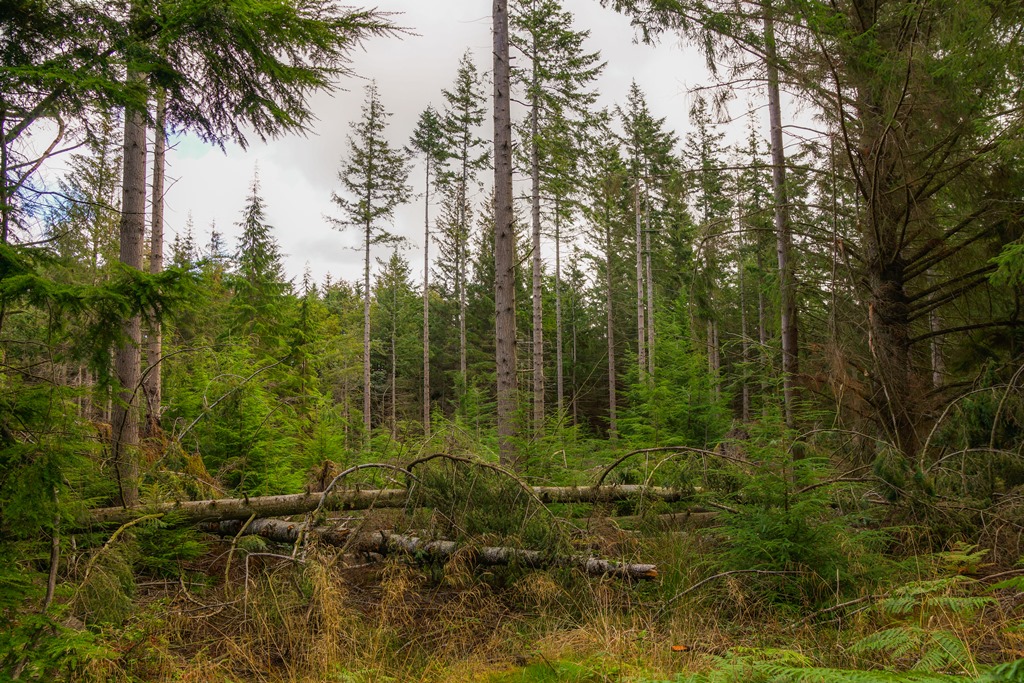
Stand 2
This stand contains a population of mature Corsican pine trees from the initial planting phase in the forest. These are now very large, dominant individuals. Their performance has been very good. Unfortunately, due to red band needle blightthere was a programme of gradual replacement with alternative conifers. The main effect of the fungus is to reduce the functional leaf area leading to greatly reduced productivity and in some cases tree mortality. Elsewhere in the stand, areas with western hemlock were thinned approximately 20 years ago to provide pokers for the nearby aluminium plant.
The current strategy is a group selection system with some underplanting to enrich the species diversity. Norway spruce is commonly planted into the small gaps. This is a shade tolerant species that performs well under moderate shade. At the next intervention the groups will be widened to release the seedlings that were planted.
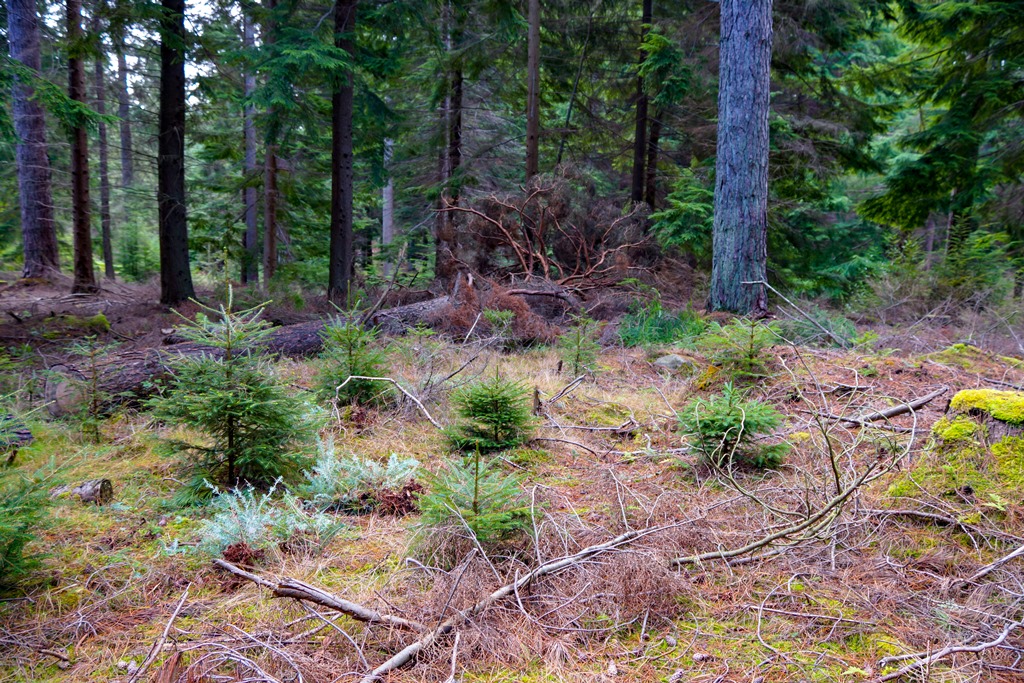
Stand 3
This stand was initially planted in 1910 and comprises coast redwood, giant sequoia and Douglas fir. Some of the largest redwoods have a volume of approximately 20 m3. For some of the largest material there is a good market in garden sleepers. Also in this stand is an area that has been coppiced. Other minor species include swamp cypress and Monkey puzzle. Pacific silver fir (Abies amabilis) is a species of interest for re-stocking and underplanting in the forest, but there are procurement issues finding good stock that performs in this area.
Wind damage from Storm Arwen has created a large area that requires re-stocking. Some of the woodland is quite productive land and this is leading to a significant weed problem. Weevils are also an important impediment to re-stocking, especially in larger coupes that have been salvaged and where there is significant debris material to support the weevil population.
Stand 4
This stop was on one of the upper ridges of the forest where the soils are relatively shallow. Extensive damage occurred here; for example, it took three weeks to clear all the roads from downed trees. Adjacent to this stand is an area that has been thinned. This is normally achieved by “harvester select”; it is rare for marking to take place.
Timber extraction is by conventional forwarder for smaller dimension material. For larger material the forest has retained a skidder. This is a modified Ponsse Ergo that is now called the “Rhino”. This machine has been working in the wood for 16 years and proved highly reliable for the extraction of large-dimension stems.


Stand 5
This was a 20 ha area that experienced catastrophic wind damage in Storm Arwen. The stand was mostly composed of mature Sitka spruce and western hemlock. Salvage operations took place in 2022. All merchantable timber was removed and the brash was gathered and chipped. The re-stock plan was to plant with Douglas fir and Sitka spruce. Options were to trench mound (excavator plant £600-700/ha), scarify or hot plant. Natural regeneration of western hemlock is expected to infill the site. It is anticipated that the western hemlock will be respaced later.
Take Home Messages
- The long-term vision of successive owners has resulted in the forest that we see today. The early spirit of experimentation with many species of conifers has resulted in a highly diverse and novel forest ecosystem, one that has given the current team of forest managers great opportunity for creativity in their silvicultural approach; one with a degree of resilience embedded in the current structure of the forest. The engagement and enthusiasm of the management team has made it possible to deliver a diverse range of economic, ecological and social objectives.
- The visit highlighted the importance of intermediate interventions to promote individual tree stability and maintain the productivity of the forest, and to regulate the species composition. Thinning is the most important activity that helps transform the forest to continuous cover forestry. Thinning gives succeeding generations of forest managers greater opportunity to adapt to circumstances at that future time. Thinning is not without risks to stand stability, so timing and intensity of thinning interventions must be carefully considered.
- Deer management is a crucial element of management where a process of transformation is taking place and where natural regeneration is required. Deer are an important element of the forest ecosystem, but numbers must be regulated to avoid excess damage or damage to species of trees that are their preference. Ideally landowners will work together to adopt a landscape level approach to deer management, but this is difficult to achieve in practice. A constant programme of culling is the path forward to account for the constant influx of deer from elsewhere. Storm Arwen has brought more open areas to the woodland, and this makes culling somewhat easier than working in dense stands with a lot of shelter and cover for the deer.
- There is a widely held perception that there is a lack of technical and applied skills development among UK forestry graduates, especially the skills necessary to deliver CCF, such as prescription design and tree marking.
- There is a lack of skilled chainsaw operators for felling large-dimension trees:
- The UK forestry sector is keen to move away from chainsaw use due to health and safety concerns, and the wide use now of mechanised harvesting systems.
- Financing the development of CCF is an issue that requires more discussion. There are new programmes emerging in other countries, notably Ireland, to support new approaches, including CCF. These support the forestry team while they develop skills and experience in implementing the transformation of even-aged to irregular structure stands.
- To encourage more woodland owners to actively manage their woodlands, it may be desirable to promote and incentivise CCF through a dedicated grant scheme.
- Forest stand and species dynamics are a key component of stand transformation to continuous cover forestry. Shade tolerant species, such as western hemlock require re-spacing and early removal in some stands so that alternative conifer species can be introduced. Other species that are more light demanding may require active management to support their growth and retention in the future forest.
- Natural disturbance from wind is an unpredictable but inevitable feature of long term woodland management in the UK. Kyloe Wood has experienced several major storms, including Storm Arwen in 2021. Although highly disruptive to scheduled management activities, new opportunities are presented through the salvage and restocking programme. Woodlands that comprise a range of stand types and a high degree of structural diversity are likely to be best placed to resist and recover from major disturbance events.
- Shelterwoods are proving a practical option for opening stands and allowing for a combination of natural regeneration and under-planting with shade tolerant species, such as Norway spruce. This is viewed by the forestry team at Kyloe Wood as a transitional and practical approach that increases structural diversity of the woodland in a way that can be more fully implemented and supported than wider use of a single-tree selection strategy through the site.
- Single-tree and group selection systems are being employed sparingly across the forest, depending on species requirements and current stand structure. To some extent, the flexibility of the systems being used is reminiscent of freestyle silviculture (e.g., Diaci et al. 2011), where a range of interventions are applied in close proximity to deliver the transformation.
- Proximity to markets is a consideration when cultivating large-dimension timber. The forests of the future are likely to produce a more diverse range of products and size classes.
- To implement a CCF management policy, it is necessary for foresters to adopt a flexible approach to management, adapting silvicultural interventions in response to regeneration success, forest health and other factors including wind damage.

Acknowledgements
Thanks to the owners of Kyloe Wood and the local team of Scottish Woodlands for hosting this field meeting. Also the organisers of the meeting and members of CCFG, RSFS and RFS for interesting discussions and lively debate about many aspects of silviculture.
Further Information
- Begg, J., and J. Ogilvie. 2023. CCFG autumn visit to Kyloe Woods, Northumberland 16 September 2022 – report. Continuous Cover Forestry Group [CCFG] Newsletter 47: 2.1-2.5.
- Connell, C. A. 1939. Royal Scottish Forestry Society, 1938 Meeting [Northumberland]. Journal of the Forestry Commission 18: 59-63
- Diaci, J., G. Kerr and K. O’Hara. 2011. Twenty-first century forestry: integrating ecologically based, uneven-aged silviculture with increased demands on forests, Forestry: An International Journal of Forest Research 84(5): 463-465, https://doi.org/10.1093/forestry/cpr053
- Forest Research. 2023. The UK Forestry Standard, 5th Edition. Forest Research, Farnham, England. 134 pp. URL: https://www.gov.uk/government/publications/the-uk-forestry-standard. Hart, C. 1995. Alternative silvicultural systems to clear cutting in Britain: a review. Forestry Commission Bulletin 115. HMSO, London. 120 pp.
- Wilson, S.M. 2013 Progress of adoption of alternative silvicultural systems in Britain: an independent review. Technical Report. Independent Study supported by Scottish Forestry Trust and Forestry Commission, p. 49.
- Wilson, S.M. 2013 Adoption of alternative silvicultural systems in Great Britain: a review. Quarterly Journal of Forestry 107 (4), 279-293.
Image Note: Images on this webpage are free to use for educational purposes. Please inform me of image use via my contact page here. It is also possible to request hi-res copies of images for publication purposes. Any material used should include the following credit: © 2022 Edward R. Wilson/Silviculture Research International.
Citation
- Wilson, E. R. 2023. Continuous cover forestry (CCF) at Kyloe Wood, Northumberland, England. Report on a joint CCFG/RSFS/RFS study visit, 16 September 2022. Forest Report. SRI-2023-FR02. Silviculture Research International. Published: 01 Dec 2023. URL: https://silviculture.org.uk/continuous-cover-forestry-at-kyloe-forest-northumberland-england
Websites
- Continuous Cover Forestry Group – https://www.ccfg.org.uk
- Royal Scottish Forestry Society – https://www.rsfs.org.uk
- Royal Forestry Society – https://rfs.org.uk
Date uploaded: 1 Dec 2023
